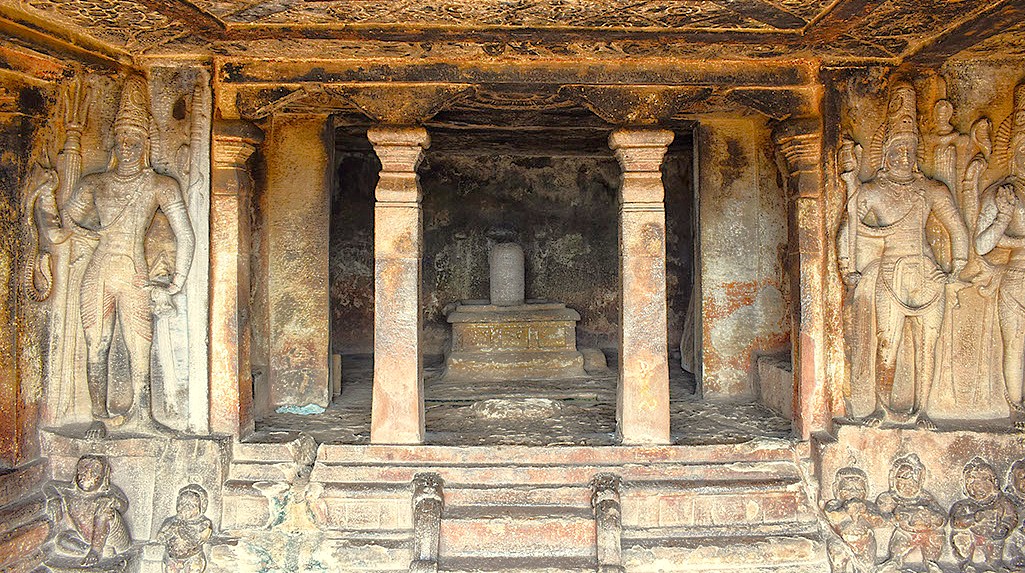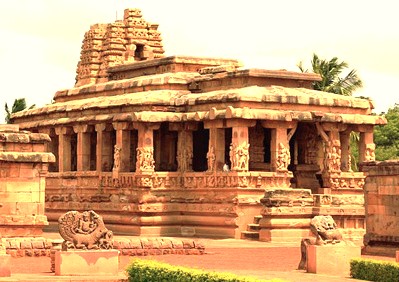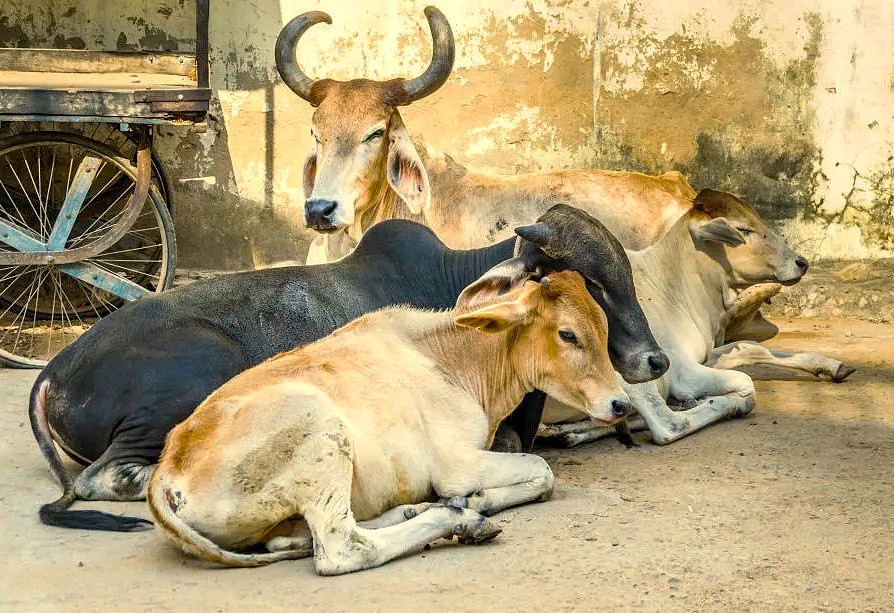Echoes of Ancient Lands
Galaganatha Temple Aihole India
Mother Masala Tours
Construction Testing Ground
Galaganatha Temple Aihole India. Holds immense historical and cultural significance, dating back to the 7th century CE. It was built during the reign of the Chalukya Dynasty, specifically under the patronage of Pulakeshin II, who ruled from 610 CE to 642 CE. The name "Galaganatha" is derived from the local language, meaning "Lord of the Mountains," indicative of its dedication to Shiva. Aihole was an essential center for temple construction and development during ancient times, acting as a cradle for innovation in sacred design.

Galaganatha Temple Aihole India: Sacred Spaces
Temple Aihloe, houses numerous artifacts unique to its history and spiritual significance. The temple itself is an example of early Hindu temple design, characterized by a simple yet elegant layout comprising an Antarala (vestibule), garbhagriha (sanctum), and a pillared hall. Among its many features is a large Shiva linga, representing the deity's phallic form and symbolizing cosmic creation. The richly carved stonework includes intricate depictions of various deities, celestial beings, and scenes from Hindu mythology that enrich the spiritual experience of anyone who enters.
Ancient Mosaics: Impeccable Craftsmanship

Galaganatha Temple Aihole India. Constructed in the 7th century CE, the Temple stands as an example of skill from the Chalukya Dynasty. Stone carvings display attention to precision and detail, with figures and motifs shaped by experienced artisans of the time. Moving through the complex, we notice surfaces covered in patterns and forms that reflect work done by craftsmen such as Vishnuvardhana. These features show scenes and stories from a different era, all revealed in stone. The arrangement of each section allows us to observe their approach to art and structure, simple yet effective.
The Pulse of the Local Community
The region surrounding the Galaganatha Temple Aihloe is characterized by its friendly and welcoming locals. Their vibrant spirit stems from a deep appreciation for their cultural heritage, which is beautifully reflected in their daily lives. Known for their hospitality, the residents of Aihole maintain a strong bond with their traditions and are eager to share stories of their history with anyone who takes an interest.
Capturing the Magic: A Photographic Haven

The Galaganatha temple invites us to capture its history through our lenses. The ancient stone carvings reveal centuries of skill and attention to detail. As we move through the complex, the calm surroundings provide plenty of space for relaxing and photographing every part. Each corner has its own story shaped by years of devotion and tradition. The views around the site change as the day goes on, letting us try different perspectives and lighting. Exploring the grounds, we discover quiet spots for photographs and shared moments as a group. The temple stands ready, revealing art and architecture in simple ways, creating a good setting for photos and easy exploration.
Festivals of Devotion: Honouring the Sacred and the Divine
Galaganatha Temple Aihole India. Plays a central role in various local festivals that honor the divine, attracting pilgrims and devotees from across the region. One intriguing festival is Maha Shivaratri, celebrated annually, during which people come together to honor Shiva. This festival usually occurs in February or March, with rituals that include night vigils, offering prayers, and lighting lamps throughout the temple. The Aihole Utsav, typically held in January, is another occasion where cultural programs, folk dances, and devotional music attract people from all walks of life.
The Connection with the Gods

Shiva is known as the creator in many legends from Hindu tradition. Stories describe Shiva shaping the universe with his dance, creating stars, planets, and life as energy flows from his movements. The Ganga river flows from his hair, bringing water to the world. Nagas, or divine serpents, often appear in these stories, moving with Shiva and guarding sacred paths. At this Temple, Shiva is honored as the force who begins creation and sets life in motion. Legends describe him as calm yet powerful, and brought the universe into existence with a single thought or dance.
Ancient Technologies: Sacred Sound, Geometry & Astrological Influences
The design of the Temple reflects the Chalukyan understanding of sacred geometry - Vastu Shashtra, with precise proportions that are believed to create harmonious energies. The layout of the temple aligns with the cardinal directions - an essential practice that enhances its spiritual significance. Using locally sourced granite and sandstone, the construction provides not only structural stability but also distinct acoustic qualities. The temple serves as a resonant space for chanting and rituals, amplifying the sounds of worship and connecting the earthly plane with the cosmos. The incorporation of Solfeggio frequencies - specifically 396 Hz (liberation) and 528 Hz (transformation) - is believed to help create healing effects during spiritual practices.
Serendipitous Meetings: Beyond the Main Path

We walk through Aihole, finding local artisans and their crafts. As we walk through the village, we discover skilled potters, weavers, and craftsmen. They keep ancient techniques alive with steady effort. Their workshops often open, revealing traditional practices to observers. We see demonstrations showing their methods clearly. This offers a chance to purchase various handmade products directly from them. The craftspeople work with simple tools, creating both useful and decorative pieces. This adds to the calm everyday atmosphere of the village surroundings.
Resilience and Renewal: Overcoming Adversity’s Challenges
Galaganatha Temple Aihole India. The history of the region is defined by resilience against various adversities. One crucial event was the invasion by the Rashtrakutas in 757 CE, which closely followed conflicts with neighboring kingdoms. These battles deeply impacted the local population and led to a period of upheaval and transformation. Through these trials, the community found ways to adapt, preserving their cultural heritage even amidst destruction. Restoration efforts post-invasions allowed the temple and the surrounding area to revive its significance as a spiritual place. In the early 20th century, there were also efforts to maintain the temple’s integrity, establishing it as an essential part of India's historical narrative.
Urban Legends: Strange Sightings, Myths and Mysteries

We hear the legend of Parashurama and the red river as we walk in Aihole. Parashurama arrives at the Malaprabha River and washes his axe after avenging his father in legend. The water turns red, and a local woman cries, Ayyo, hole, naming the place Aihole there. We stand by the bank and see the river’s color linked to this long-told local story. Galaganatha Temple sits on the river bank, revealing how the legend frames the surrounding historic landscape. We note the shrine’s presence, the pathways, and the steady activity around the complex daily. We move on, simple travelers, listening and watching the river’s flow and the temple nearby.
Let Your Next Chapter Begin Here, Join Us
We invite you to embark on a special journey to the Galaganatha Temple in Karnataka, India, a sacred place where ancient history and profound spirituality truly converge. This is a chance to go deeper. Together, we will explore the intricate myths and legends interwoven within its ancient stones, stories that speak of gods and kings. We'll also step beyond the monuments to indulge in authentic local flavors and embrace the remarkable warmth of the community. With every step, you will uncover the rich stories and cultural traditions that have shaped this incredible site over many centuries.
Symphony of Generosity: Offerings from Wanderers to Residents
